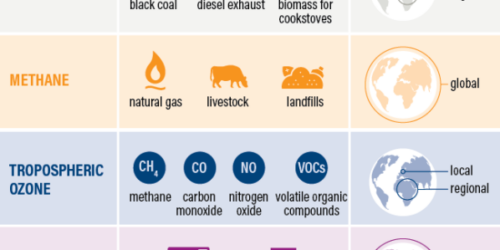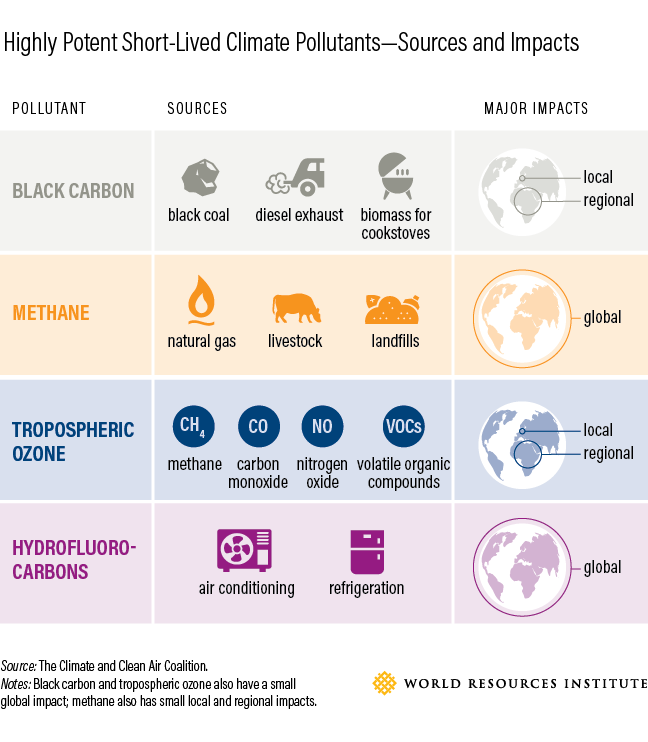Short-Lived Climate Pollutants: What They Are and Why They Are a Big Deal

This blog was originally published on Climatelinks.
Air pollution is the world’s largest environmental health risk, contributing to an estimated 6.7 million premature deaths each year globally. It is also a critical development challenge because low and middle income countries (LMICs) experience the greatest health burdens from poor air quality. Low air quality is closely linked to global climate change because air pollutants and greenhouse gases (GHGs) often share emission sources, and certain air pollutants, collectively known as short-lived climate pollutants (SLCPs), directly contribute to climate change.
Short-Lived Climate Pollutants and Climate Change
On April 21, 2021 the U.S. Government announced its commitment to enhance global efforts to address climate change and enable the transformations required to reach net-zero emissions by 2050. The U.S. Government is launching a Global Climate Ambition Initiative that will support developing countries in establishing net-zero strategies and implementing nationally determined contributions and adaptation strategies under the Paris Climate Agreement.
USAID, in coordination with other U.S. Government agencies, will work to support developing countries in meeting their climate goals in ways that promote their national development priorities. For example, reducing SLCPs is a key transformational change for limiting warming to 1.5℃—an ambition that all countries signed on to as part of the Paris Climate Agreement. The Intergovernmental Panel on Climate Change’s (IPCC) Special Report on Global Warming of 1.5ºC found there is no plausible scenario for limiting warming to 1.5℃ without simultaneous deep reductions in carbon dioxide and SLCPs.
What Are Short-Lived Climate Pollutants?
SLCPs are powerful pollutants like methane (CH4), black carbon, tropospheric ozone, and other hydrofluorocarbons (HFCs) that significantly affect climate change. They have a relatively short lifespan in the atmosphere, ranging from a few weeks (black carbon) to as long as two decades (methane and HFCs). SLCPs in the atmosphere can cause increases in global warming, sea level rise, accelerated melting of glaciers and land ice in the Arctic, and decreased air quality.
Health & Agriculture Impacts
Ozone and black carbon are highly toxic air pollutants, which severely threaten human health, ecosystems, and food security. Methane is an important precursor gas of tropospheric ozone, and black carbon is a component of fine particulate matter (PM2.5). PM2.5 are very tiny dust, smoke, soot, and liquid droplet particles (less than 2.5 micrometers – thinner than a human hair) that when inhaled can penetrate our lungs and bloodstream causing lung disease and severe cardiovascular and neurological problems. Tropospheric ozone, more commonly known as ground-level ozone, is also a cause of asthma and chronic respiratory illnesses, and adversely affects crop production in highly polluted regions. For instance, in India, ground-level ozone damages millions of critical crops each year, which scientists estimate could feed 94 million people living in poverty. PM2.5 and ozone are responsible for about one-third of deaths from stroke, chronic respiratory disease, and lung cancer as well as one quarter of deaths from heart attack. The United Nations Environment Programme (UNEP) estimates that measures taken to reduce black carbon emissions (eg. the elimination of high-emitting vehicles, introducing clean burning stoves in low-income countries, and improving solid waste/wastewater management systems) by 2030 can prevent nearly 2.4 million premature deaths annually. Fast action on methane can also significantly reduce ground-level ozone, leading to an increase in global crop yields by 26 million tons per year. Ambitious reductions in SLCPs are critical for achieving the United Nations Sustainable Development Goals and the Paris Climate Agreement.
Climate Impacts
SLCPs are the strongest levers countries have for slowing global warming in the near-term while complementing necessary efforts to reduce carbon dioxide emissions. Scientists estimate that immediate action on SLCPs could help prevent 0.4°C of global warming and over 50 percent of predicted Arctic warming by 2050, thereby significantly decreasing the chances of triggering dangerous climate tipping points. Additionally, reducing SLCPs can reduce the rate of sea level rise by roughly 24-50 percent. Scientists estimate that decreasing sea level rise by 0.1 meter, can prevent the displacement of nearly 10.4 million people globally. (To understand how sea level rise will affect the United States, check out the National Oceanic and Atmospheric Administration’s Sea Level Rise Viewer.)
USAID Action on Air Quality and Short-Lived Climate Pollutants
USAID invests in mitigating air pollution and reducing SLCPs across the world through several programs that focus on urban centers and marginalized communities often affected the hardest by air pollution and climate change. These programs have supported community-based air pollution mitigation efforts, as well as work that combines satellite technology and on-the-ground measurements to inform air quality and public health efforts across the world. To improve air quality and reduce SLCPs, USAID recently launched Clean Air Catalyst, a new flagship program to mitigate air pollution, alongside a global consortium of organizations led by the World Resources Institute and the Environmental Defense Fund. Through this program, USAID and its partners will work with local communities to better understand local pollution sources and identify, test, accelerate, and scale solutions for cleaner, healthier air.

Credit: World Resources Institute

